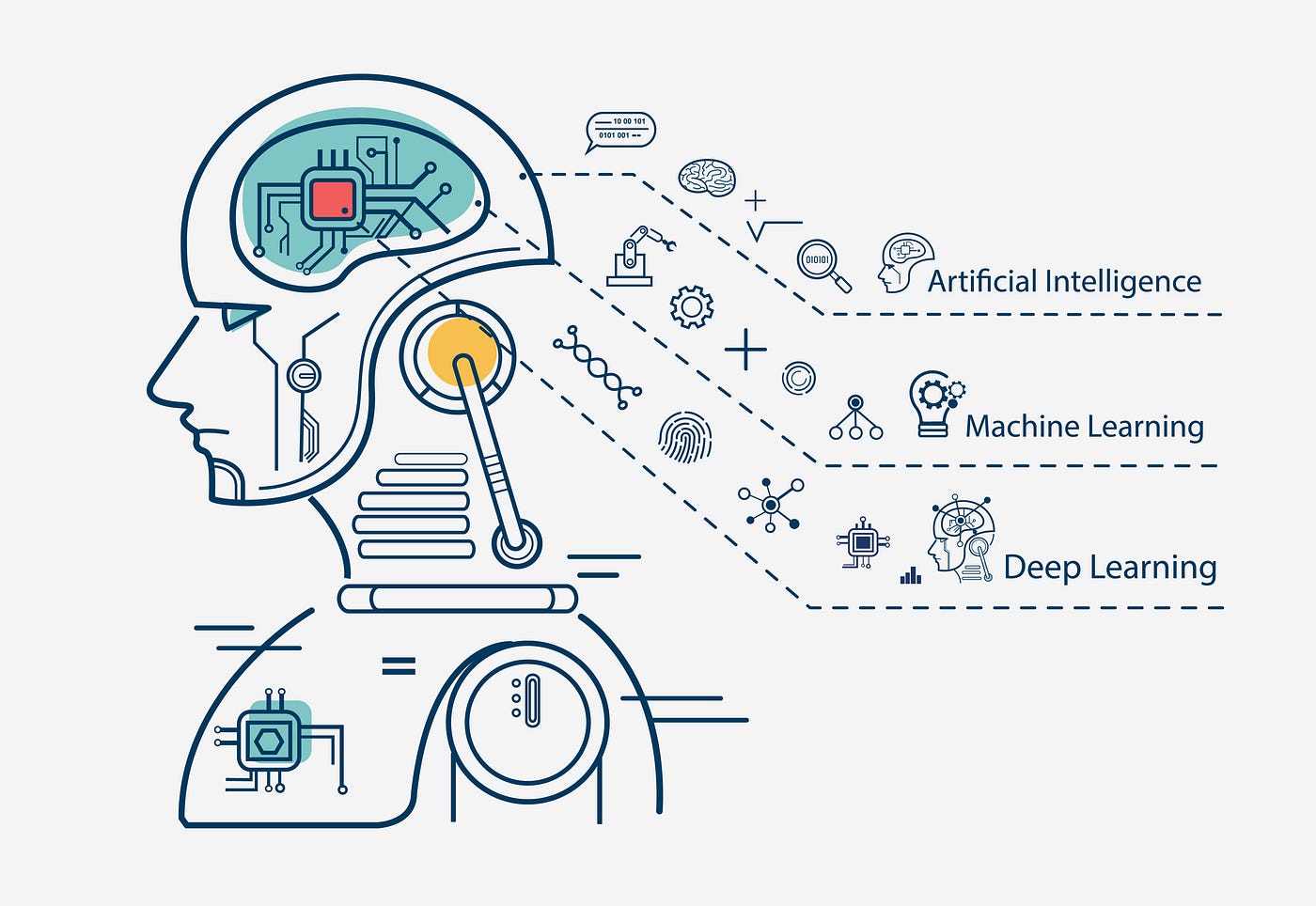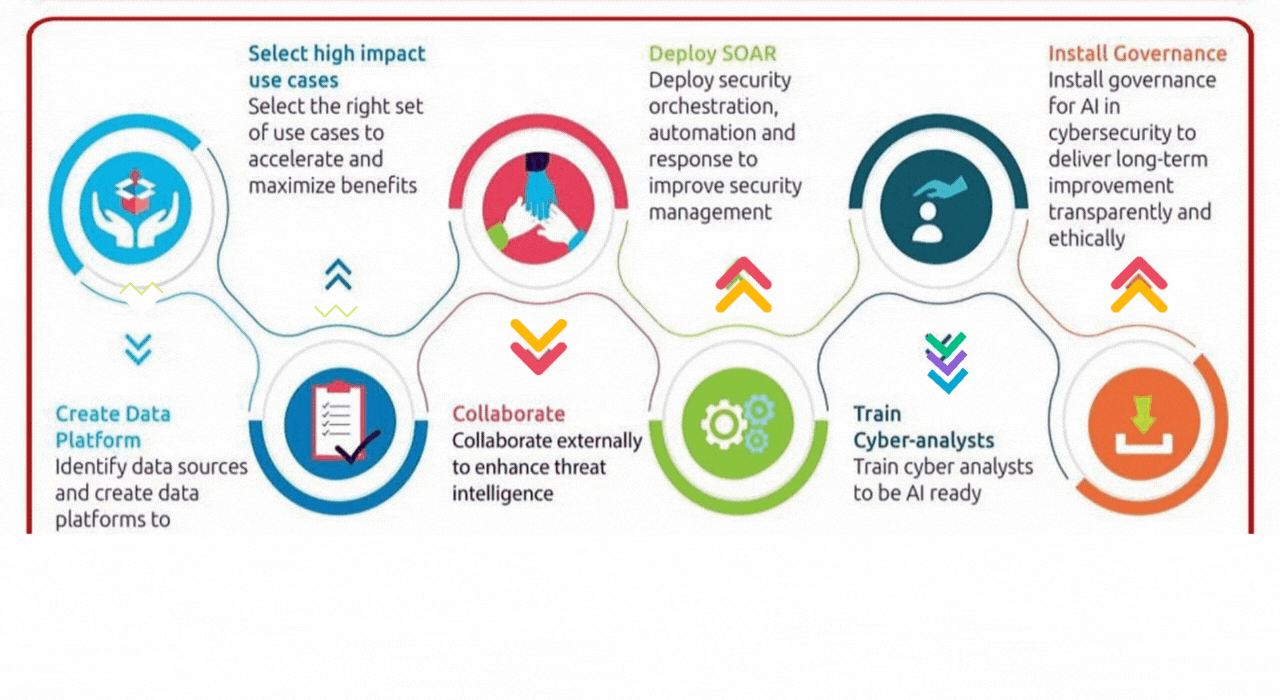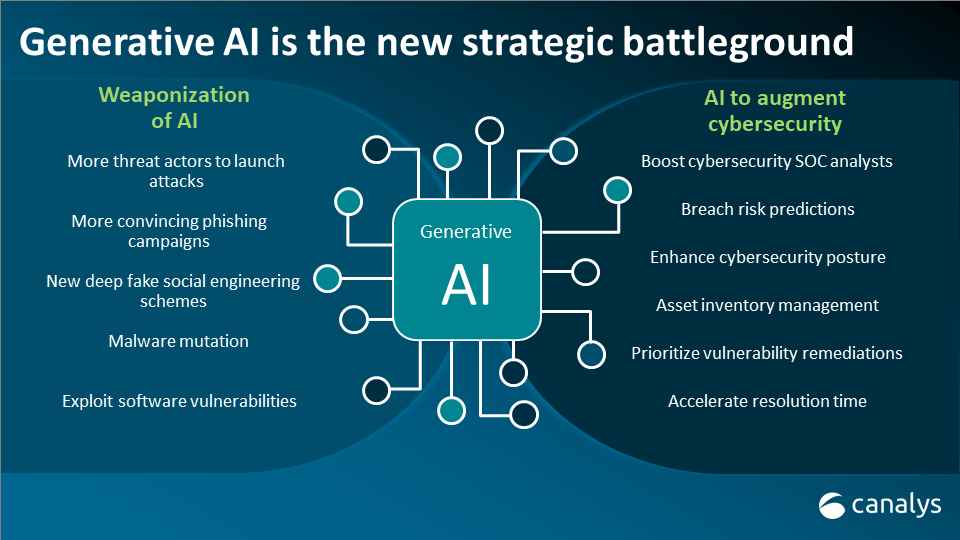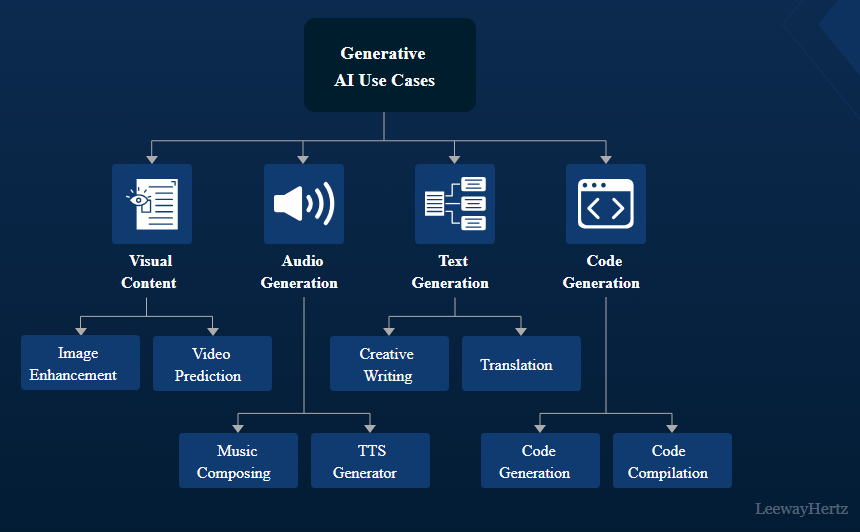AI in Cyber Security
Have you ever wondered how companies protect their valuable data from cyber-attacks?
With the increasing complexity of cyber threats, traditional security measures may no longer be enough. It has become more important than ever to secure our data and digital assets.
And, the perfect due to combat cyber threats – Artificial Intelligence (AI) in Cyber Security.

Artificial Intelligence (AI) is revolutionizing the field of cybersecurity by augmenting traditional defense mechanisms with advanced algorithms and automation. AI, Machine Learning, and Deep Learning play a pivotal role in automating critical cybersecurity processes. By leveraging these technologies, organizations can streamline tasks such as threat detection, incident response, and vulnerability assessment.
Generative AI models have shown great potential in various industries, including healthcare, finance, manufacturing, and more. With their ability to generate synthetic data and simulate scenarios, these models can aid in medical research, financial risk analysis, and product design.
In this article, we will explore the advantages of AI in cyber security and how it is transforming the way we secure our data.
So, fasten your seatbelt, and let’s dive into the world of AI in cyber security!
Facts
The latest report by Verified Market Research suggests that the market size for Artificial Intelligence in cybersecurity stood at 7.58 billion dollars in 2022 and is expected to reach 80.83 billion by 2030. The growing number of cyber-attacks shouldn’t come as a surprise since hackers also have access to advanced technologies.
In line with this, a report from Pillsbury, a global law firm specializing in technology, revealed that 44% of organizations worldwide already utilize AI for detecting security breaches.
Contents
Role of Generative AI in Cyber Security

The role of generative AI in Cyber Security is becoming increasingly important in today’s digital age. AI analyzes vast amounts of data in real time, identify potential threats, and predicts future attacks. It improves the technologies that companies use to combat cybercriminals and helps organizations keep customer data safe.
AI can also automate routine security tasks, freeing up human experts to focus on more complex and strategic security issues. AI in Cyber Security is applicable in various areas, including threat detection, fraud prevention, identity and access management, and incident response.
In cyber security, artificial intelligence proves to be beneficial as it improves the way security experts analyze, study, and understand cybercrime.
AI in cybersecurity: Risks & Challenges

Source – canalys.com
Machine learning has brought tremendous benefits to businesses, helping them make informed decisions, automate tasks, and gain valuable insights. However, integrating generative AI into cybersecurity systems presents its own set of challenges and risks.
Gaurav Keerthi, Deputy Chief Executive Officer at the Cyber Security Agency of Singapore, highlights the dual nature of AI in cybersecurity, stating that while it holds promise, it can also pose threats.
Let’s take a look at some of the challenges associated with integrating AI into cybersecurity:
- Data Manipulation: AI systems rely on data to learn and identify patterns. Hackers can gain access to this training data and manipulate it by introducing biases or altering it to their advantage. Such actions can compromise the accuracy and effectiveness of AI models, potentially leading to security breaches.
- AI-Powered Cyber Attacks: Hackers can utilize AI techniques to develop intelligent malware that can adapt and modify itself to evade detection by even the most advanced cybersecurity software. This makes it increasingly difficult for traditional security measures to keep up with evolving threats.
- Data Availability: The performance of AI models heavily relies on the quantity and quality of data available for training. If the training data is insufficient or contains biases, the AI system may not perform as expected. Inadequately trained models can result in false positives, providing a false sense of security and leaving organizations vulnerable to undetected threats.
- Privacy Concerns: AI models often require access to real-world user data to accurately understand user patterns. Without appropriate measures like data masking or encryption, this sensitive data becomes vulnerable to privacy breaches, potentially exposing users to security risks and malicious exploitation.
- Attacks on AI Systems: AI systems themselves are not immune to cyber-attacks. Hackers can intentionally feed poisoned or manipulated data to these models, altering their behavior to serve their malicious objectives. This underscores the importance of protecting AI systems from malicious manipulation.
Despite these challenges, it is crucial to approach AI integration in cybersecurity with a balanced perspective. Building robust infrastructures and implementing measures to mitigate these risks can create a safer environment for digital systems to operate securely.
To further understand the risks and challenges associated with AI in cybersecurity, you can explore the implications of generative AI models in this insightful blog post – Types of Generative AI Models
Generative AI Use Cases in Cyber Security

Source – leewayhertz.com
As technology advances, the risk of cyber threats and attacks grows higher.
To combat these risks, companies are turning to Artificial Intelligence (AI) to enhance their cybersecurity measures. They are eager to know, how is AI used in cyber security. This innovative approach utilizes ML algorithms to detect potential threats and prevent attacks.
Here is the list of use cases of generative AI in Cyber Security:
1. AI-Enabled Threat Detection and Response
AI has the power to analyze massive amounts of data and identify patterns and anomalies that may indicate a cyber attack.
This allows security personnel to respond to threats quickly and mitigate their impact. Meanwhile, AI is trained to recognize new and emerging threats, helping organizations stay one step ahead of cybercriminals.
It allows organizations to significantly enhance their cybersecurity defenses and better protect their data and digital assets.
2. AI’s Role in Ransomware Attacks Mitigation
When someone intentionally holds your files or system hostage and demands money in return for giving you your website’s access back, it’s called a ransomware attack. By scanning your website with the Malware scanner, you can detect common bugs and check your website’s security.
AI-based cybersecurity systems are designed to be better at finding malicious traits. According to Chuck Everette, who works in cybersecurity at Deep Instinct, traditional antivirus systems can stop around 30% to 60% of threats, while AI-powered systems have a success rate of 80% to 92%.
Researchers at Plymouth University worked on a technique called computer vision. They transformed files into colorful images that clearly show the difference between malicious and harmless files.
Using neural networks, the researchers achieved an overall accuracy of 74% in detecting malware across all file formats.
They were even able to reach 91.7% and 94.1% accuracy in detecting malware in .doc and .pdf files, respectively.
Also, read How Generative AI is Helping in Reducing the Risk of Errors
3. Fraud Detection with AI in Cyber Security
With the rise of digital transactions and financial data, companies need advanced technology to detect potential fraud or financial crimes. AI can analyze massive amounts of financial data to identify patterns and anomalies that may indicate fraudulent activity. It can also monitor financial transactions in real-time, alerting security personnel to suspicious activity. Hence, AI can protect companies’ financial assets and ensure that their customer’s data is secure.
4. Enhancing Network Security with AI
AI can analyze vast amounts of network traffic data and identify potential vulnerabilities. This technology monitors network activity to detect and respond to threats as they arise, preventing damage before it occurs. With AI in network security, organizations can have a more proactive approach to cybersecurity and prevent threats from penetrating their networks.
This means AI has revolutionized the way network security is managed and has become an essential part of any organization’s cybersecurity strategy.
5. AI-Powered User Authentication and Access Control
Unauthorized access to sensitive data and systems can lead to significant security breaches and data leaks. This technology plays a vital role in ensuring that only authorized users have access to sensitive data and systems. AI analyzes user behavior and access patterns to identify potential security risks and prevent unauthorized access.
It can also help detect unusual user behavior, such as unusual login attempts or unusual access patterns, which could indicate a security breach. With AI-based user authentication and access control, organizations can enhance the security of their data and systems and prevent cyber threats.
6. Countering Phishing Attacks with AI in Cyber Security
Hackers have a common method called phishing, where they send harmful links to people through emails. The goal is to trick them into giving away sensitive information or disrupting their computer systems. When someone clicks on these harmful links, it activates malware (malicious software).
Luckily, artificial intelligence (AI) can help detect phishing attacks. Researchers at the University of North Dakota came up with a technique that uses AI to analyze the structure of emails and determine if they are legitimate or phishing emails. They trained their system with 4000 samples and achieved an impressive accuracy of 94%.
One example of an effective AI-based tool for detecting phishing is Mimecasts’s CyberGraph. It identifies the patterns and blocks harmful elements in emails that could reveal sensitive information. The tool also looks for patterns and uses identity graphs to spot phishing attempts. If a threat is detected, it alerts users with color-coded warning banners.
Cofense is another well-known company in the cybersecurity field. They acquired Cyberfish, a provider of AI systems for phishing protection. By combining their expertise in machine learning, computer vision, and detection and response, they have developed a real-time protection system against phishing attacks.
In addition to detecting phishing, AI can also analyze malware based on its characteristics. For example, if software is designed to delete or encrypt files without permission, it is likely to be a threat. AI can quickly identify such malicious software and help protect against it.
Also, read our in-depth blog post on Generative AI vs Machine Learning vs Deep Learning
7. AI for Detecting and Prioritizing New Threats
As software architectures become more complex, the number of potential vulnerabilities also increases. In fact, in 2022 alone, there were over 22,000 newly registered vulnerabilities, marking the highest recorded number since 2009, according to Statista.
Keeping up with all these digital threats is a daunting task for cybersecurity professionals. However, thanks to machine learning, AI-powered cybersecurity systems can stay on top of global and industry-specific vulnerabilities.
These systems continuously update their AI models with the latest data on threats and vulnerabilities, enabling them to defend against new threat actors and proactively prevent future attacks. The success of AI in the cybersecurity field has caught the attention of major tech companies like Google, IBM, and Microsoft.
For instance, Google has committed to investing $10 billion over the next five years to advance cybersecurity through various initiatives. One of their notable projects is Project Zero, a team dedicated to finding and fixing web vulnerabilities to make the internet a safer place. Additionally, Google Play Protect scans over 100 billion apps regularly to detect and protect against malware and other cyber threats.
Microsoft’s Cyber Signals program leverages AI to analyze a staggering amount of data, including 24 trillion security signals, 40 nation-state groups, and 140 hacker groups. This program is designed to detect malicious activities and identify software-related weaknesses.
According to Microsoft’s report, the Cyber Signals program successfully blocked over 35.7 billion phishing attacks and prevented 25.6 billion identity theft attempts on enterprise accounts.
8. Leveraging AI for Malware Detection and Prevention
Malware can take many forms and can be difficult to detect with traditional security measures. However, AI can analyze large amounts of data to identify malware patterns and anomalous behavior that may indicate a malware attack.
It can also learn and adapt to new types of malware, improving the accuracy of detection and prevention. This way organizations can enhance their overall cybersecurity posture and reduce the risk of damaging malware attacks.
9. Predicting Breach Risk with AI in Cyber Security
Large enterprises possess a vast inventory of IT assets, but evaluating each component for potential security breaches can be a daunting task. However, with the help of artificial intelligence (AI) tools, this complex process becomes more manageable.
AI tools are capable of identifying the components within the inventory that are most vulnerable to breaches and can even predict the types of attacks that are likely to occur.
To enhance security measures, researchers have introduced cognitive learning-based models that monitor access points for authorized logins. These models continuously analyze login activities and can swiftly detect any signs of remote hacking attempts. Once a potential breach is identified, users are promptly alerted, and additional security layers can be implemented to prevent any potential data breaches.
When organizations receive early information about hacking incidents and breaches, they can gain valuable insights that enable them to allocate their resources and tools more effectively. This proactive approach allows them to better prepare for future attacks and develop robust cyber resilience.
10. Behavioral Analysis and Anomaly Detection Using AI in Cyber Security
AI analyzes user behavior and network traffic to identify patterns and anomalies that may indicate a cyber attack. It can also detect and respond to unusual behavior in real-time, preventing potential attacks before they can cause damage.
With the help of machine learning, AI can learn and adapt to evolving threats, making it an invaluable tool for detecting and responding to cyber-attacks. AI can help organizations quickly detect and respond to potential security breaches by detecting unusual patterns and anomalies, minimizing the impact of cyber attacks.
To learn more about the role of machine learning in enhancing cybersecurity, you can explore the comprehensive machine learning services offered by RedBlink.
11. AI-Based Vulnerability Assessment and Management
AI applications in cybersecurity encompass a wide range of capabilities. AI can analyze systems and applications to identify potential vulnerabilities, such as outdated software or weak passwords. This automates the vulnerability assessment process and significantly reduces the time and resources needed to maintain security.
AI can also assist in prioritizing vulnerabilities based on their potential impact, allowing security personnel to focus on the most critical threats first. The top impact of AI on cyber security is that with AI-powered vulnerability management tools, organizations can proactively address security risks and minimize the chances of a successful cyber attack.
Also, check out our blog post on Generative AI Applications Use Cases
12. Automation of Cyber Security Tasks using AI
In the world of cybersecurity, time is of the essence. The longer it takes to detect and respond to cyber threats, the more damage they can cause. When relying on manual processes for threat detection and mitigation, attackers have ample opportunity to carry out their malicious activities, such as encrypting or stealing data, covering their tracks, and creating hidden access points within your system.
However, with the power of artificial intelligence (AI), we can automate the process of threat detection and response, significantly reducing the time it takes to safeguard against cyber threats. According to IBM, by employing AI methodologies, the time required to detect and take action against these threats can be reduced by an impressive 14 weeks.
Hence, implementing an AI-enabled automated threat detection solution can effectively process billions of network requests, endpoints, user activities, and data points daily. These vast amounts of data are analyzed in real-time, providing instant insights and allowing for immediate action to be taken within minutes, as opposed to the hours or even days it may take through manual threat detection methods.
Generative AI: Cyber Security Use Cases
There are tremendous benefits of AI in cyber security. Explore how Generative AI enhances security with the help of neural networks. It provides real time information about threats and solutions. Here we have explained to you the use cases of generative AI in cyber security –
- Threat Detection and Response
- Ransomware Attacks
- Fraud Detection
- Network Security
- User Authentication and Access Control
- Phishing Attacks
- Detect & Prioritize New Threats
- Malware Detection and Prevention
- Breach Risk Prediction
- Behavioral Analysis and Anomaly Detection
- Vulnerability Assessment and Management
- Task Automation
Future of Generative AI in Cyber Security
Securing an organization’s network is paramount in today’s technological age, and vulnerability management is the key to achieving it. Daily, companies face a deluge of threats that they must first detect, classify and then mitigate to prevent any potential damage. To manage all these vulnerabilities, one must analyze and assess the security measures available through AI research, which proves to be of great assistance.
The future holds even greater promise for securing an organization’s or system’s safety. Artificial neural networks can learn patterns over time and aid in identifying potential threats that share similar characteristics. This early detection is critical in blocking such threats, and AI technology applied to cybersecurity makes it all the more difficult for hackers to infiltrate.
As AI continues to learn and improve from various situations, it makes it increasingly challenging for hackers to outsmart the system.
Also Read: How To Build A Generative AI Solution
Conclusion
With the growth of companies and the increased activity of their networks, generative AI in cyber security becomes a critical aspect of protecting data from malicious attacks.
With vast amounts of data transferred daily between customers and organizational servers, it becomes a daunting task for cyber security personnel to monitor and detect potential threats. This is where the innovative solution of Artificial Intelligence (AI) comes into play.
Generative AI has emerged as a vital tool for enhancing the performance of IT security groups. With the help of RedBlink’s AI Consulting Services, and Generative AI development services you can easily identify threats and secure your business websites from cyber crimes. Hire ChatGPT developers, Machine Learning engineers on hourly or monthly basis.
Clearly, AI enables the discovery and targeting of potential risks, accelerates incident response, and identifies malware attacks before they occur. To learn more about how AI can revolutionize cyber security, take the initiative to explore this rapidly evolving field with our help of us.

Director of Digital Marketing | NLP Entity SEO Specialist | Data Scientist | Growth Ninja
With more than 15 years of experience, Loveneet Singh is a seasoned digital marketing director, NLP entity SEO specialist, and data scientist. With a passion for all things Google, WordPress, SEO services, web development, and digital marketing, he brings a wealth of knowledge and expertise to every project. Loveneet’s commitment to creating people-first content that aligns with Google’s guidelines ensures that his articles provide a satisfying experience for readers. Stay updated with his insights and strategies to boost your online presence.
